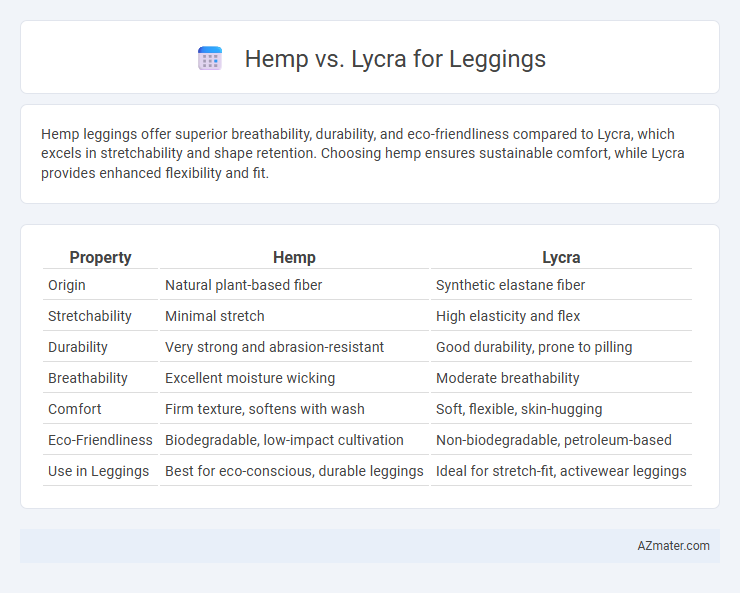Hemp leggings offer superior breathability, durability, and eco-friendliness compared to Lycra, which excels in stretchability and shape retention. Choosing hemp ensures sustainable comfort, while Lycra provides enhanced flexibility and fit.
Table of Comparison
| Property | Hemp | Lycra |
|---|---|---|
| Origin | Natural plant-based fiber | Synthetic elastane fiber |
| Stretchability | Minimal stretch | High elasticity and flex |
| Durability | Very strong and abrasion-resistant | Good durability, prone to pilling |
| Breathability | Excellent moisture wicking | Moderate breathability |
| Comfort | Firm texture, softens with wash | Soft, flexible, skin-hugging |
| Eco-Friendliness | Biodegradable, low-impact cultivation | Non-biodegradable, petroleum-based |
| Use in Leggings | Best for eco-conscious, durable leggings | Ideal for stretch-fit, activewear leggings |
Introduction to Leggings: Hemp vs Lycra
Leggings made from hemp fibers offer superior breathability, durability, and natural antimicrobial properties compared to lycra, which is valued for its exceptional elasticity and moisture-wicking capabilities. Hemp fabric provides sustainable, eco-friendly benefits, making it an ideal choice for environmentally conscious consumers seeking comfortable athletic wear. Lycra, a synthetic material, excels in stretchability and shape retention, making it suitable for high-performance activities requiring maximum flexibility.
Material Origins and Sustainability
Hemp leggings are made from fibers derived from the Cannabis sativa plant, known for requiring minimal water, pesticides, and synthetic fertilizers, making it a highly sustainable textile option. Lycra, a synthetic fiber produced from petrochemicals through a polymerization process, is less eco-friendly due to its reliance on non-renewable resources and energy-intensive manufacturing. Choosing hemp over lycra supports eco-conscious apparel by reducing environmental impact through renewable material origins and biodegradability.
Comfort and Texture Comparison
Hemp leggings offer a breathable, natural texture that becomes softer with wear, providing exceptional moisture-wicking and antimicrobial properties for enhanced comfort. Lycra leggings deliver a smooth, stretchy feel with superior elasticity, ensuring a snug fit that retains shape and supports movement during physical activities. While hemp prioritizes durability and eco-friendliness with a slightly coarse initial texture, lycra excels in flexibility and a silky, smooth surface ideal for high-performance wear.
Breathability and Moisture-Wicking Properties
Hemp leggings offer superior breathability due to the fiber's natural porous structure, allowing increased airflow and preventing overheating during intense workouts. Lycra, while providing excellent stretch and shape retention, has limited moisture-wicking capabilities compared to hemp, often trapping sweat and reducing comfort. Hemp's inherent antimicrobial properties further enhance its moisture management, making it an ideal choice for breathable, moisture-wicking activewear.
Stretch and Flexibility Differences
Hemp leggings offer moderate stretch but lack the high elasticity found in Lycra, making them less flexible for intense physical activities. Lycra, known for its superior stretch and shape retention, provides exceptional flexibility and comfort ideal for dynamic movements. Choosing between hemp and Lycra depends on the need for natural fiber benefits versus enhanced stretch performance.
Durability and Longevity
Hemp leggings offer exceptional durability due to their strong natural fibers, resisting wear and tear longer than many synthetic options, including Lycra. Lycra, known for its elasticity, provides excellent stretch but tends to lose resilience and shape retention over time with frequent washing and use. Choosing hemp leggings ensures longer-lasting performance and sustainability, making them ideal for those prioritizing durability and longevity in activewear.
Impact on Skin: Hypoallergenic Qualities
Hemp leggings provide superior hypoallergenic qualities due to their natural antimicrobial properties, making them ideal for sensitive or allergy-prone skin. Lycra, while stretchy and comfortable, is a synthetic fiber that may cause irritation or allergic reactions in some individuals with sensitive skin. Choosing hemp leggings reduces the risk of skin irritation and promotes healthier skin by minimizing exposure to synthetic allergens.
Environmental Impact and Eco-Friendliness
Hemp fabric offers a significant environmental advantage over Lycra, as it requires minimal water, pesticides, and synthetic fertilizers during cultivation, making it highly sustainable and biodegradable. Lycra, primarily composed of polyurethane, is a synthetic fiber derived from petrochemicals, contributing to carbon emissions and microplastic pollution during washing and disposal. Choosing hemp for leggings supports reduced ecological footprint, promotes soil health, and minimizes chemical use compared to the resource-intensive and non-biodegradable nature of Lycra.
Care and Maintenance Requirements
Hemp leggings require minimal care, thriving with gentle machine washing in cold water and air drying to maintain their natural fibers and prevent shrinkage. Lycra leggings demand careful maintenance, including washing in cold water with mild detergents, avoiding high heat drying, and refraining from fabric softeners to preserve elasticity and prevent fiber breakdown. Both materials benefit from avoiding bleach and ironing at low temperatures, but hemp offers greater durability and resistance to pilling compared to Lycra.
Ideal Use Cases: Fitness, Leisure, and Beyond
Hemp leggings offer exceptional durability and breathability, making them ideal for high-intensity fitness activities and outdoor leisure. Lycra provides superior stretch and shape retention, perfect for yoga, pilates, and dynamic workouts requiring flexibility and support. For everyday wear, combining hemp's eco-friendly qualities with Lycra's comfort creates versatile leggings suitable for both active lifestyles and casual use.

Infographic: Hemp vs Lycra for Legging
 azmater.com
azmater.com